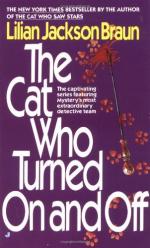|
This section contains 392 words (approx. 2 pages at 300 words per page) |

|
Written at a time of intense interest in the American infrastructure, The Cat Who Turned On and Off deals with a major issue of the 1960s: the choice between historical preservation and urban renewal. Everyone, from bank executives to taxi drivers, assumes that Junktown will soon be razed and its buildings replaced by modern buildings with upscale offices, shops, and apartments. At the same time, however, some people were beginning to consider the importance of an area's heritage and ethnic flavor, and aside from its nostalgic appeal, restoration of these unique neighborhoods was coming to be seen as a practical and economical alternative to the construction of new buildings. Frequently proponents of these two attitudes clashed over the fate of individual buildings and specific neighborhoods.
Another important social issue of that era is the responsibility of the Establishment toward blighted areas.
As Qwill discovers, outsiders assume...
|
This section contains 392 words (approx. 2 pages at 300 words per page) |

|




